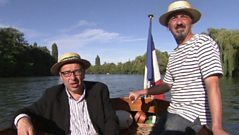
The Great Outdoors
Waldemar Januszczak continues his investigation of the Impressionists by taking us outdoors to their most famous locations.
Waldemar Januszczak continues his investigation of the Impressionists by taking us outdoors to their most famous locations. Although Impressionist pictures often look sunny and relaxed, achieving this peaceful air was hard work. Trudging through fog, wind and rain, across treacherous coastal rocks and knee-deep snow, Waldemar shows how the famous spontaneity of the Impressionists is thoroughly misleading.
This episode visits the French riverside locations that Monet loved to paint, and where Renoir captured the bonhomie of modern life. Waldemar also introduces a number of technical and practical developments of the age which completely revolutionised Impressionist painting - the invention of portable easels; the use of hog's hair in paint brushes; as well as the introduction of the railway through France. And a scientific demonstration in a Swedish snowdrift explains just how right the Impressionists were to paint brightly coloured shadows in their winter scenes, despite being accused of 'hallucinating' at the time.
Finally, Januszczak explains Cezanne's part in the Impressionist story from his dark and challenging early work to his first rural landscapes in France, and then his departure from Paris and separation from the Impressionist gang.
Last on
Clip
-
![]()
A look at Renoir's 'dancing couples' paintings
Duration: 03:15
Music Played
-
![]()
Ben Becker
Die Legion
Credits
| Role | Contributor |
|---|---|
| Presenter | Waldemar Januszczak |
| Writer | Waldemar Januszczak |
| Producer | Susan Doyon |


